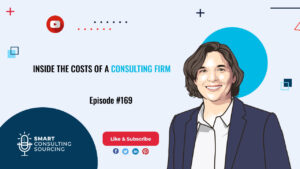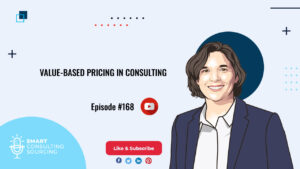Hello and welcome to episode 11 of our podcast. Smart consulting Sourcing. The podcast about consulting procurement.
My name is Helene and I’ll be your host today. Each week I’ll give you the keys to better use manage and source consulting services.
In this episode, I’ll talk about how to monitor the consulting category. Last week, we discussed about why I think consulting is a standalone category.
It may sound obvious but you won’t see the benefits of your management unless you measure the impact.
So, the prerequisite to monitoring your consulting category is to have established a baseline or in other words, you have performed a first diagnosis of your consulting expenses and your consulting performance.
So, what exactly do you need to monitor?
So, there are several elements that you need to look at.
- Number one, the easy part: financial. The consulting spend itself. How much I’m spending on consulting?
- Number two, the performance. It’s how well my consulting providers are doing.
- Number three, is the ROI. Do I really get the value for my money?
- And number four is the respect of the processes. How well do we respect our consulting sourcing processes internally.
First of all, you need to segment because looking at the category as a whole doesn’t always bring enough information to identify trends and patterns.
What are the dimensions that you can use to monitor the consulting category?
The first one is obviously the capability. What type of project is it? Is it consulting? is it operation? You need to have internally a taxonomy of capabilities so you can describe your project.
And if you’re looking for one, at least to start with, you can find one on the resource section of our website, smartconsultingsourcing. And you can go there and download it.
Another dimension is the size of the project. Is it a small project? or a large project?
Third dimension would be the strategic importance and the impact. This is really important to understand if you really focus on what accelerates your strategy versus just any project that comes through.
And the last part is, who is handling the procurement process. To understand if everyone is respecting the processes the way they should.
Define your targets
So, when you have your segmentation, you can define your target. And there’s a quote I really like from Bill Copeland, the Australian athlete, he said “the trouble with not having a goal is that you can spend your life running up and down the field and never score.”
And it’s really relevant because unless you have set a goal for your consulting, there’s no way you can make sure you’re still on tracks.
So, what we recommend to your clients is to set targets, at least guidelines, for the different segments of consulting for three different things. First, the level of expenses, second, the level of performance you expect, and third, the expected return on investment.
When you are in a turnaround or a crisis context, you could also limit the number of projects that are not presenting tangible benefits in less than one year.
And by tangible benefits, I mean measurable benefits, such as cost savings, sales increase, anything that impact you know the bottom line or the top line.
Monitor your consulting category, all of it
And you also need to track everything, even the tail. And you know companies often monitor the consulting projects that go through the centralized indirect procurement group.
But they think that those smaller projects are not relevant. But you know that the tail spent, when unmanaged, can just aggregate small expenses to add up to gigantic. So, you really have to integrate everything in that analysis, including the small ones.
When you look at the performance and the ROI aspect, you need to be extremely thorough with large projects and preferred providers. Because that’s the element that had the largest impact on your consulting spend.
So I’m going to give you another quote! This time from Benjamin Franklin; which is “Beware of little expenses, a small leak will sink a great ship!” This is the perfect quote for tail spend.
It’s not because it’s small projects that it doesn’t have a big impact on your consulting spend. And one of the biggest mistakes in consulting is that, considering is very often decentralized, that tail spent is inflated and absolutely out of control.
Create a dashboard
So, next of course, create a monthly dashboard to monitor the consulting category. Again it seems obvious that month dashboard has to be monthly or at least quarterly to monitor the consulting category.
So, you have to be aware that consulting is very often seasonal with a peak at the beginning of the year and a clear slowdown in the last quarter.
So, while you’re cruising through the peak period, you have to monitor the consulting category and be careful that you don’t burn all your consulting budget in three minutes.
And you might think to keep some money in the bank to absorb a last-minute strategic project. And also, make sure that you monitor at the same time expenditures – what you paid, and engagements – what is still to be produced, so you can avoid these end-of-year surprises.
And you have to keep track of the permanence of your major project and providers to make sure you always get the best ROI. So, you see that to monitor the consulting category can yield substantial value creation for your organization.
It will help you keep expenses under control and make sure your projects are delivering an impact in ROI right.
That’s it for today, next week I’ll discuss the main pitfall when writing an RFP.
In the meantime, if you have any questions or want to learn more about consulting quest, just send me an email at Helene.laffitte@consultingquest.com
Bye and see you next week! Au revoir!
See you at the next episode. Till then, stay safe and stay connected with us through our community on LinkedIn
and follow our Twitter handle @ConsQuest. Don’t forget to like and subscribe to our channels
Podbean
YouTube
Happy Sourcing!
monitor the consulting category.monitor the consulting category.monitor the consulting category.monitor the consulting category.monitor the consulting category.







